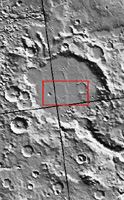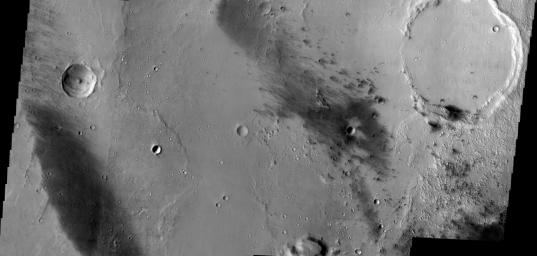
Released 3 January 2004
This evening at approximately 8:35 PST the Mars Exploration Rover named Spirit will bounce to the ground somewhere in this scene. The image is composed of nine THEMIS VIS frames that have been mosaiced together, producing a complete picture of the region in which the rover is predicted to land.
The dark streaks are places where wind has either scoured off the brighter martian dust or has covered it up by sand. Note the interesting lobes of material evident along the right side of the image just below the large crater. These may be due to the emplacement of water rich sediments or possibly lava flows. It is hoped that Spirit and all of its instruments will help us to understand the rich geologic history that is on display in this image. The biggest question to be answered: was Gusev Crater filled with water sometime in its ancient past? Stay tuned...
Mosaic produced by Noel Gorelick, ASU/THEMIS Team.
Image information: VIS instrument. Latitude -14.8, Longitude 175.2 East (184.8 West). 19 meter/pixel resolution.
Note: this THEMIS visual image has not been radiometrically nor geometrically calibrated for this preliminary release. An empirical correction has been performed to remove instrumental effects. A linear shift has been applied in the cross-track and down-track direction to approximate spacecraft and planetary motion. Fully calibrated and geometrically projected images will be released through the Planetary Data System in accordance with Project policies at a later time.
NASA's Jet Propulsion Laboratory manages the 2001 Mars Odyssey mission for NASA's Office of Space Science, Washington, D.C. The Thermal Emission Imaging System (THEMIS) was developed by Arizona State University, Tempe, in collaboration with Raytheon Santa Barbara Remote Sensing. The THEMIS investigation is led by Dr. Philip Christensen at Arizona State University. Lockheed Martin Astronautics, Denver, is the prime contractor for the Odyssey project, and developed and built the orbiter. Mission operations are conducted jointly from Lockheed Martin and from JPL, a division of the California Institute of Technology in Pasadena.

 Planetary Data System
Planetary Data System













